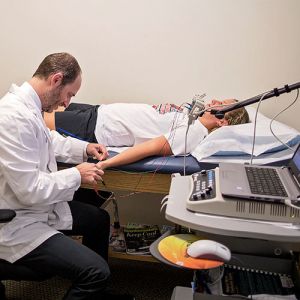Electromyography (EMG) is a diagnostic procedure used to evaluate the health and functionality of muscles and the nerve cells that control them.
An EMG is used to diagnosis patients who have symptoms or exam findings that could indicate a nerve or muscle disorder. The most common symptoms that call for an EMG test include:

- Numbness
- Tingling
- Muscle weakness
- Pain
- Cramping
The EMG test can diagnosis or help rule out several conditions, including muscle disorders, peripheral nerve entrapments, nerve root entrapments or peripheral neuropathies. From there, the EMG test helps the physician decide on the most appropriate treatment plan.
How it Works
A physician will use electrodes to send and receive electrical impulses between the muscles and nerves. By measuring the response of the electrical impulses, the physician is able to determine if the muscles and nerves are working properly.
There are two parts of the EMG. The first part involves nerve conduction studies using electrodes attached to the skin that help record electrical signals. The second part of the study is called a needle EMG. This is where a needle electrode is inserted into different muscles, transmitting the electrical activity of that muscle.
The results of the EMG test can reveal nerve dysfunction, muscle dysfunction or problems with the communication between the muscles and nerves.
